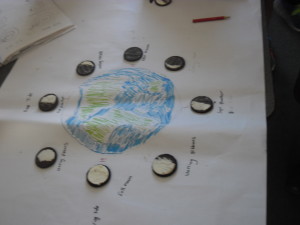Where does the Sun Go at Night?

Most of us are curious beings and we attempt to make meaning from our lives, our world, the universe and all the ‘stuff’ within. Children are no different and they often have built elaborate ideas for why things happen. Quite often though, the ideas are disorganised or have no scientific basis. These preconceived misconceptions may be deeply rooted and very difficult to shift. This is particularly so for concepts regarding space.
As a diagnostic assessment to my current space unit, I wanted to assess my student’s preconceived ideas about the Earth, Sun and moon system. By Grade 7 (age 11- 12), students will have completed two previous science units on space and have observed phenomena from the sun and moon on countless occasions. Despite this, a significant portion of both classes I assessed (n = 46) had a limited understanding of scientific explanations and had built their own misunderstandings for various phenomena such as day / night, moon phases, seasons and the tides.
| Question | Correct | Most Common Misconception | Sample Responses |
| Where does the Sun go at Night? | n = 11 | the sun moves to the other side of the earth(n= 21). | the sun goes behind the moon (n=7)to space behind the cloudsthe sun and the moon both shine on different parts of the EarthThe sun rotates around our planet so when the sun passes us we have daylight.It goes around the galaxy |
| Why does the moon change shape at night? | n = 10 | The clouds are covering it(n=7) | the moon has different partsthe moon is a planet so it will keep movingbecause of the seasonsbecause the dark side changes each nightit’s getting lateonly some of it can light upit came out earlier and the sun rotates around itother planets get in between the moon and the sun |
| Why can you see the moon during the day? | n = 4 | clear sky (n = 4) | Because there are no clouds to cover it upYou might not be fully around to see itThe moon might be moving to Europe* several children provided no response to this question (n=24) |
| Why do we have seasons? | n = 3 | We are closer to the sun in summer (n = 10) | if we are facing the Sun that’s summer, if we are not facing the Sun that’s winterit gives the universe time to blend togetherthe weather causes themin winter the moon is out more so its colder, in summer the Sun is out more so its warmerit happens when the moon goes around the earthglobal warming caused themsometimes the planet doesn’t always orbit the sunthey change when the moon orbits around the earth |
| Why do we have tides? | n = 7 | The moon is a water magnet / magnetic forces (n = 7) | The moon makes light waves that moves the waterThe waves push the waterWhen two plates under the ocean move it causes the water in the ocean to moveThe windThe moon changes shapeThe earth turning |
Now other than being highly entertaining to read, identifying children’s misconceptions is an important part of science teaching. Whilst admittedly some of the above responses may have been guesses, the children were asked to provide their best reason. The responses included here are a sample of the wide variety provided by the children.
For children to alter their preconceived ideas, they must face an unsettling period of cognitive dissonance. Teachers must expose the children to enough examples that challenge the child’s way of thinking. Mostly in science, this is done through experiential learning. When children witness with their own eyes something that is in conflict with their preconceived misconceptions they begin to alter their understandings to a more accurate scientific accurate way of thinking.
The challenge then for learning concepts about the Earth, Sun and moon system is to provide the children with a variety of models to demonstrate space phenomena. Polystyrene balls become model Earths, torches become suns, Oreo biscuits can become moons. Thankfully there is a wide range of interactive resources available to support the learning as well. One of my favourites would be the Sun Moon Scope on http://www.solarsystemscope.com/sunmoonscope/ which enables the children to select any date of the year to observe the trajectory of the Sun and determine the moon phase. With this resource, children can see cyclical change in moon phases. Oreo Moon Phases
Oreo Moon Phases
Obviously, it is my aim that by the summative assessment stage of this unit most of the children will be able to answer the diagnostic assessment questions with greater scientific accuracy and clarity. Reminds me though of the study by the Australian Academy of Science earlier this year, where some 40% of those people surveyed did not know that it takes one year for the Earth to orbit the Sun. Seems some misconceptions are hard to shift. Just as I tell the children, we must keep on learning.
Spencer D (2013-09-04 00:20:07). Where does the Sun Go at Night? . Australian Science. Retrieved: Nov 14, 2025, from https://ozscience.com/education/where-does-the-sun-go-at-night/
 Follow
Follow
Hi Danielle, Very interesting article. I am going to set my Year 7s the same questions and see what misconceptions they have. BTW, who had the task of eating the Oreo biscuits to match the phases of the moon? Donna